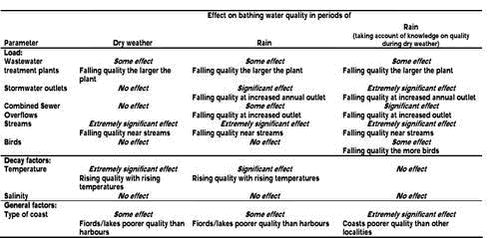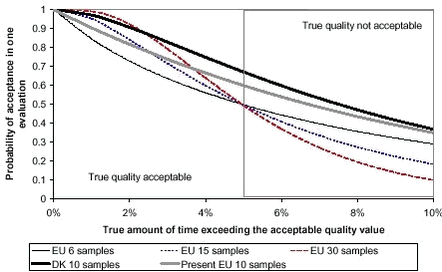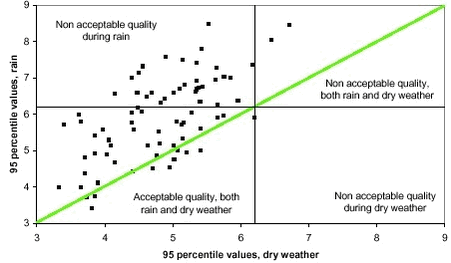Vurdering af konsekvenser af forslaget til nyt badevandsdirektiv fra EU, dateret 24.10.2002Summary and conclusionsBackground and objectivesThe study Main conclusion Project results For a number of years, the bathing water quality in Denmark has been checked based on the Danish Bathing water regulation, using the method described in the Danish Environmental Protections Agency‘s guideline from 1985 on bathing water. A draft EU directive on bathing water presents a new method and reduces the acceptable level of microbiological pollution in bathing waters. Thus, the consequences of the EU draft directive on the evaluation of the bathing water quality have been examined, including an estimation of the number of existing Danish monitoring stations that will not be able to meet the future requirements on acceptable bathing water if the EU directive is adopted. Furthermore, it has been examined which factors have the greatest effect on the bathing water quality, in order to prepare a targeted effort towards these factors. Background and objectivesIn Denmark a large number of monitoring stations comply with the current criteria for evaluation of bathing water quality. Since the preparation of The EU bathing water directive and the Danish bathing water regulation, the WHO has published studies which indicate that the present requirements in the directive do not provide a sufficient safeguard against the development of diseases in connection with bathing. The revision of the EU bathing water directive has been in progress for some time. The latest draft dated 24 October 2002 (EU, 2002) includes a statistical method for checking the quality of bathing water, and a reduction of the acceptable microbiological pollution level to a maximum of 5% of the time during which the content of E.coli must exceed 500/100 ml. The objective of this study is to examine the additional number of bathing water stations to be rejected if The EU new draft bathing water directive is adopted. Further, the objective is to point out the most important factors affecting the bathing water quality. This will form the basis for a constructive discussion of The EU draft directive and help determine the prioritisation of efforts to be accomplished in order to improve the bathing water quality. Finally, the evaluation can be used to optimise bathing water sampling in order to obtain a reasonable safety level in the determination of the bathing water quality compared to the resources available for control of bathing water. The studyThe study focuses on two subjects: The consequences of a possible adoption of The EU draft directive are described by comparing the control methods in The EU draft directive with the Danish method and other alternatives. The study includes data on bathing water quality from four counties in Denmark: Frederiksborg, Bornholm, Funen and Northern Jutland. The comparison was made partly by using the mathematical structure of the methods and partly by using data from historical bathing water samples (1995-2001) from selected Danish bathing water stations. Furthermore, the consequences of collecting only a minimum of samples, as made possible in The EU draft directive, have been assessed. The consequences have been examined both year by year and for a 5-year period. The sources of faecal pollution, the factors determining the decrease of bacteria and other parameters affecting the bathing water quality are, to the extent possible, described both generally and quantified for the individual bathing water samples and stations. The importance of parameters has been studied both individually and weighing their influence on the bathing water quality. That part of the study focuses on data from Frederiksborg county. The importance of the individual parameters has been estimated by recording connected values for parameters and measured number of faecal coliforms on all bathing water samples and by mathematical evaluation of correlations between parameters and faecal coliforms. The interaction between the parameters and their individual importance has been evaluated using empirical statistical models. In the report, only the indicator organism faecal coliforms has been used for estimation of requirement compliance, even though the requirements in The EU draft directive are based on enterococci and E.coli. In Denmark, however, sufficient bathing water data are available only for faecal coliforms. The actual number of E.coli is (somewhat) lower than the number of faecal coliforms, thus the calculation overestimates the number of stations to be rejected by implementation of the new EU draft directive. On the other hand, the number of rejected stations is underestimated, since the consequences of possible new requirements for enterococci have not been evaluated. In Denmark only few enterococci samples have been collected, it is, therefore, not possible to predict how many stations might be rejected as a result of the new requirements. Some stations might be rejected although they meet the requirements for E.coli. Main conclusionThe conclusion of the comparison of consequences of the Danish control method and the method described in The EU draft bathing water directive are as follows:
Conclusion on factors affecting the on resulting hygienic bathing water quality:
The table below gives an indication of the effect of different parameters on the bathing water quality in periods of dry weather, periods of rain, and periods of rain where account is taken of the quality during dry weather. Project resultsErroneous classification of stations cannot be avoided unless continuous samples of the bathing water are collected, i.e. an infinite number of samples. Erroneous classification is rejection of stations with acceptable bathing waters and acceptance of stations that should be rejected. A method for evaluating a limited number of samples will include a predetermined probability for approval of a bathing water station just meeting the requirements. In the EU draft directive, a probability of 50% for approval/rejection of a station is predetermined, whereas the Danish system presupposes 67% for approval and 33% for rejection. The present EU directive has a probability of 60% for approval of a station just meeting the requirements. This is illustrated in Figure 1, which also shows that an increased number of samples will increase the probability for approval/rejection of a station.
Based on existing historical bathing water samples from the individual stations, a year to year evaluation was carried out based on the different evaluation methods. Table 1 below shows the percentage of the total number of bathing stations rejected in the period 1997-2001 in accordance with the present Danish method (DK, 1 year, 1000) and after the EU draft (EU, 3 years, 500), respectively. As an average for all four counties, 2.9 % of the bathing stations are rejected each year based on the present Danish system, whereas 8.9 % of the stations are rejected based the EU draft directive.
The comparison can also be made over a 5-year period where only stations which have been approved all 5 years are regarded as approved. Thus, a station which has been rejected once or more during the 5-year period will be regarded as rejected. This method of comparison is used in Table 2, where the present Danish method is compared to alternatives to the EU draft directive. The alternatives include an example where only samples for a 1-year period are used in the evaluation and not for 3 years, and another example where a criterion of approval of 5 % is attached to the number of samples as in the present directive and not to a statistical estimation of distribution.
Different factors which are assumed to affect the bathing water quality have been examined for Frederiksborg county to show that individually they have had a significant effect on the bathing water quality for the last seven years. Rain has been examined as an individual factor. A statistically very significant negative relation between rain and bathing water quality was identified. This is illustrated in Figure 2, which shows calculated compliance values for periods of rain and dry weather for each bathing water station in Frederiksborg county. It can be seen that the compliance values generally are higher (poorer bathing water quality) for the samples affected by rain at all stations than the corresponding samples collected during dry weather. The compliance values and acceptable values in the figure correspond to the EU draft bathing water directive.
|




